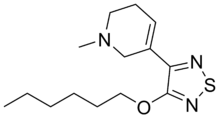Ksanomelin
Prijeđi na navigaciju
Prijeđi na pretragu

| |||
| (IUPAC) ime | |||
|---|---|---|---|
| 3-(4-heksoksi-1,2,5-tiadiazol-3-il)-1-metil-5,6-dihidro-2H-piridin | |||
| Klinički podaci | |||
| Identifikatori | |||
| CAS broj | 131986-45-3 | ||
| ATC kod | nije dodeljen | ||
| PubChem[1][2] | 60809 | ||
| ChemSpider[3] | 54797 | ||
| UNII | 9ORI6L73CJ | ||
| KEGG[4] | D06330 | ||
| ChEMBL[5] | CHEMBL21536 | ||
| Hemijski podaci | |||
| Formula | C14H23N3OS | ||
| Mol. masa | 281,42 g/mol | ||
| SMILES | eMolekuli & PubHem | ||
| |||
| Farmakoinformacioni podaci | |||
| Trudnoća | ? | ||
| Pravni status | |||
Ksanomelin (LY-246,708, Lumeron, Memkor) je agonist muskarisnkog acetilholinskog receptora sa umerenom selektivnošću za M1 i M4 podtipove.[6][7][8][9] Nije poznato da ksanomelin deluje kao antagonist M5 receptora.[10] On je bio ispitivan za lečenje Alchajmerove bolesti i šizofrenije, posebno kognitivnih i negativnih simptoma.[11] Gastrointestinalne nuspojave su dovele do visoke stope napuštanja kliničkih ispitivanja.[12][13] Uprkos tome, za ksanomelin je pokazano da ima umerenu efikasnost u lečenju simptoma šizofrenije. Jedna nedavna studija je utvrdila robustno poboljšanje pri verbalnom učenju i u kratkotrajnoj memoriji usled tretmana ksanomelinom.[14]
Reference[uredi | uredi kod]
- ↑ Li Q, Cheng T, Wang Y, Bryant SH (2010). „PubChem as a public resource for drug discovery.”. Drug Discov Today 15 (23-24): 1052-7. DOI:10.1016/j.drudis.2010.10.003. PMID 20970519.
- ↑ Evan E. Bolton, Yanli Wang, Paul A. Thiessen, Stephen H. Bryant (2008). „Chapter 12 PubChem: Integrated Platform of Small Molecules and Biological Activities”. Annual Reports in Computational Chemistry 4: 217-241. DOI:10.1016/S1574-1400(08)00012-1.
- ↑ Hettne KM, Williams AJ, van Mulligen EM, Kleinjans J, Tkachenko V, Kors JA. (2010). „Automatic vs. manual curation of a multi-source chemical dictionary: the impact on text mining”. J Cheminform 2 (1): 3. DOI:10.1186/1758-2946-2-3. PMID 20331846.
- ↑ Joanne Wixon, Douglas Kell (2000). „Website Review: The Kyoto Encyclopedia of Genes and Genomes — KEGG”. Yeast 17 (1): 48–55. DOI:10.1002/(SICI)1097-0061(200004)17:1<48::AID-YEA2>3.0.CO;2-H.
- ↑ Gaulton A, Bellis LJ, Bento AP, Chambers J, Davies M, Hersey A, Light Y, McGlinchey S, Michalovich D, Al-Lazikani B, Overington JP. (2012). „ChEMBL: a large-scale bioactivity database for drug discovery”. Nucleic Acids Res 40 (Database issue): D1100-7. DOI:10.1093/nar/gkr777. PMID 21948594.
- ↑ Farde L, Suhara T, Halldin C, et al. (1996). „PET study of the M1-agonists [11C]xanomeline and [11C]butylthio-TZTP in monkey and man”. Dementia (Basel, Switzerland) 7 (4): 187–95. PMID 8835881.
- ↑ Jakubík J, Michal P, Machová E, Dolezal V (2008). „Importance and prospects for design of selective muscarinic agonists”. Physiological Research / Academia Scientiarum Bohemoslovaca 57 Suppl 3: S39–47. PMID 18481916.
- ↑ Woolley ML, Carter HJ, Gartlon JE, Watson JM, Dawson LA (January 2009). „Attenuation of amphetamine-induced activity by the non-selective muscarinic receptor agonist, xanomeline, is absent in muscarinic M4 receptor knockout mice and attenuated in muscarinic M1 receptor knockout mice”. European Journal of Pharmacology 603 (1-3): 147–9. DOI:10.1016/j.ejphar.2008.12.020. PMID 19111716.
- ↑ Heinrich JN, Butera JA, Carrick T, et al. (March 2009). „Pharmacological comparison of muscarinic ligands: historical versus more recent muscarinic M1-preferring receptor agonists”. European Journal of Pharmacology 605 (1-3): 53–6. DOI:10.1016/j.ejphar.2008.12.044. PMID 19168056.
- ↑ Grant MK, El-Fakahany EE (October 2005). „Persistent binding and functional antagonism by xanomeline at the muscarinic M5 receptor”. The Journal of Pharmacology and Experimental Therapeutics 315 (1): 313–9. DOI:10.1124/jpet.105.090134. PMID 16002459.
- ↑ Lieberman JA, Javitch JA, Moore H (August 2008). „Cholinergic agonists as novel treatments for schizophrenia: the promise of rational drug development for psychiatry”. The American Journal of Psychiatry 165 (8): 931–6. DOI:10.1176/appi.ajp.2008.08050769. PMID 18676593.
- ↑ Messer WS (2002). „The utility of muscarinic agonists in the treatment of Alzheimer's disease”. Journal of Molecular Neuroscience : MN 19 (1-2): 187–93. DOI:10.1007/s12031-002-0031-5. PMID 12212779.
- ↑ Mirza NR, Peters D, Sparks RG (2003). „Xanomeline and the antipsychotic potential of muscarinic receptor subtype selective agonists”. CNS Drug Reviews 9 (2): 159–86. DOI:10.1111/j.1527-3458.2003.tb00247.x. PMID 12847557.
- ↑ Shekhar A, Potter WZ, Lightfoot J, et al. (August 2008). „Selective muscarinic receptor agonist xanomeline as a novel treatment approach for schizophrenia”. The American Journal of Psychiatry 165 (8): 1033–9. DOI:10.1176/appi.ajp.2008.06091591. PMID 18593778.